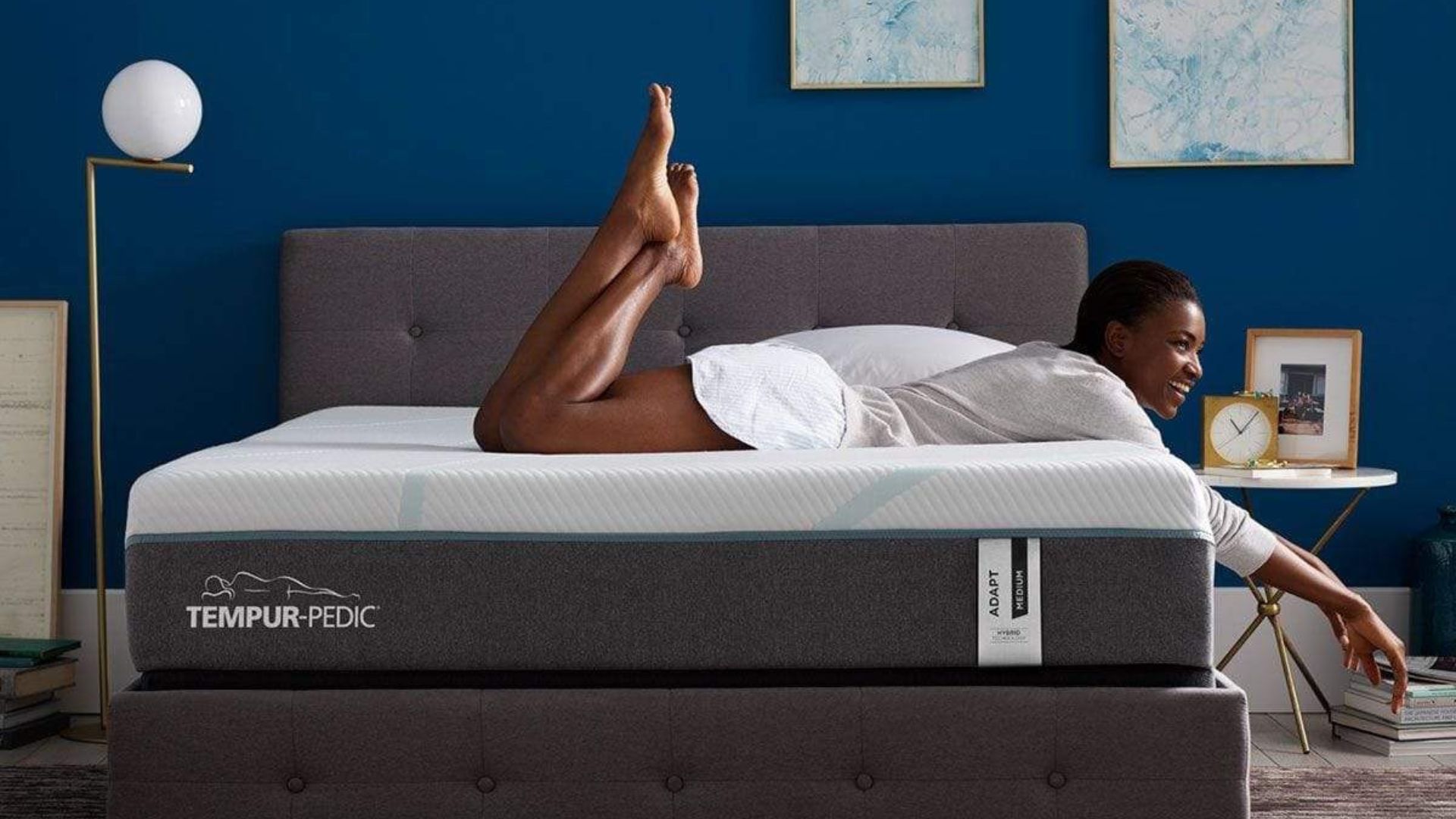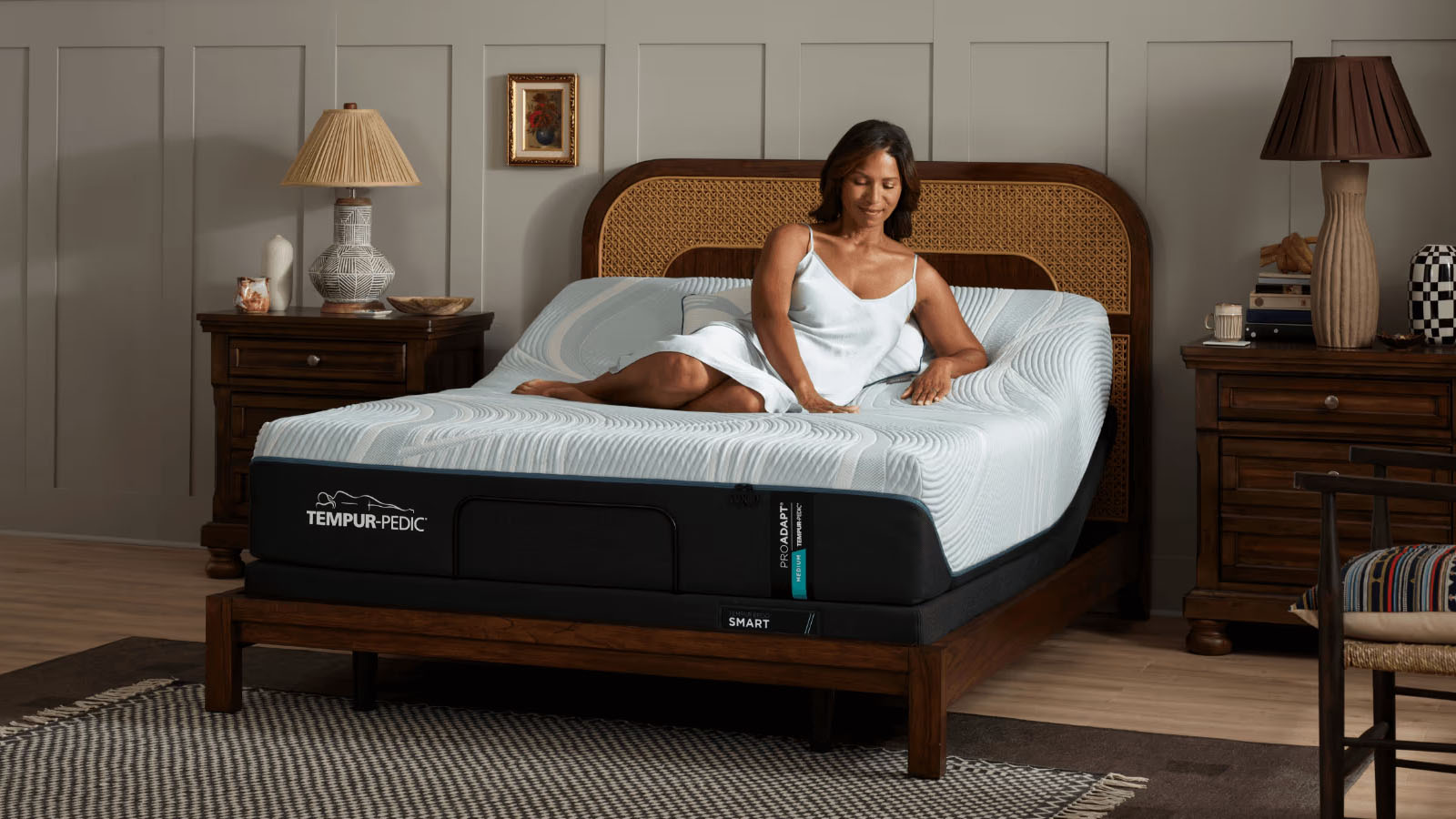Is your Tempur-Pedic mattress too firm or soft? Here's how to change the feel
You're not stuck with the feel of your mattress. If you need to make a change, follow these easy steps

Tempur-Pedic need little introduction. The brand’s mattresses are famous for their proprietary foam, high-quality materials and innovative designs. Considered by many to be one of the most premium mattresses money can buy, even the cheapest Tempur-Pedic is an investment piece.
So what happens if your new Tempur-Pedic mattress is too hard or too soft for your sleep style? When it comes to choosing the best mattress for your sleep needs and budget, Tempur-Pedic is a reliable brand that delivers specialist pressure relief and cooling technology. However, there are certain factors that can influence how firm your mattress feels.
Here, we've rounded up the six ways to adjust the firmness of your Tempur-Pedic mattress, including adjusting your bedroom's temperature and evaluating your bed base. If you're looking to replace your bed entirely, the 4th of July mattress sales are underway, making right now an excellent time to buy.
What is a Tempur-Pedic mattress?

Tempur-Pedic make some of the best luxury mattresses in the world (we included the Tempur-Pedic Tempur-Adapt mattress in our round up). The brand has been developing its proprietary Tempur foams since the 1960s, and famously acted as the designer for the material used by NASA in aircraft seats.
Nowadays the brand is, of course, equally famous for its mattresses. All that technology and know-how comes with a price tag to match, so if you're in the market for a Tempur-Pedic, we’d recommend bookmarking our Tempur-Pedic mattress sales page to keep an eye on upcoming discounts.
Tempur foam is a unique pressure-relieving synthetic foam that's similar to, but not the same as, memory foam. With a slow response time, the foam molds to the body, holding you in one position and leaving you feeling almost weightless as you sleep.
This slow sink is caused by the foam gently warming up from body heat throughout the night. Some sleepers love the deep contouring and pressure relief that Tempur-Pedic foam provides, but others can find it far too smothering. To complicate matters further, the brand now also makes firm mattresses, which have the same contouring foam backed up by a firmer support layer.
Sign up to get the BEST of Tom's Guide direct to your inbox.
Get instant access to breaking news, the hottest reviews, great deals and helpful tips.
All this variation mixed with the very personal nature of sleep comfort means you could easily end up with a mattress that feels too firm or too soft.
How to make a Tempur-Pedic mattress firmer
If you feel like you’re sinking into quicksand on your Tempur-Pedic mattress and can’t get out, these tips will help firm up your mattress.
1. Adjust your room temperature
Tempur foam responds to a sleeper’s body heat, gradually getting softer and molding to the body to create contouring pressure relief. But if you’re finding that the foam is simply getting too soft for your liking, the first step is to look at your room temperature.
Even the best memory foam mattresses can be affected by a room that’s too hot, and a warm room isn’t great for your sleeping patterns either. The recommended temperature range for your bedroom overnight is between 65 and 68F, which should keep you cool and comfortable, and avoiding overheating.
A cooler bedroom has the added advantage of firming up a foam mattress. It won’t make a huge difference, but setting your thermostat to the lower end of the recommended temperature range in winter, or adjusting your AC accordingly in summer, will help give your mattress a firmer feel.
2. Place it on a solid base

Because foam is, by nature, a softer and more moldable material, slatted bed bases can make all-foam mattresses feel softer. Open slats allow material to poke down in between them, lowering the rigidity of the mattress.
So, if your Tempur-Pedic is feeling soft, you can instantly firm it up by providing the mattress with a solid base to rest on. A flat, solid foundation base is a simple solution, or you could consider a platform bed with a solid wood or metal surface. The solid surface will give your Tempur mattress a firmer feel, and you can usually find these bed bases in a range of heights to suit your preference.
3. Add a firm (latex) topper
Natural latex mattress toppers, particularly those made with Dunlop latex, have a dense, sturdy and durable feel. This means that they can be added to a Tempur-Pedic mattress to offer it a firmer feel, adding support whilst still providing plenty of pressure relief. The durability of Dunlop latex also means that they’re good value for money and should last you longer than many toppers.
The added bonus of latex mattress toppers is that latex is a highly breathable material. Because all-foam mattresses are prone to trapping heat, a latex topper could help prevent you from overheating on your Tempur mattress.
For all the good they do, however, latex toppers are not miracle workers. If you are a hot sleeper, consider investing in one of Tempur-Pedic’s specialist cooling mattresses or one of our best cooling mattress picks.
How to make a Tempur-Pedic mattress softer
If you have the opposite problem and are finding your Tempur mattress too firm, try these tips instead.
1. Add a feather-top or down mattress topper
Although you could look at adding a memory foam topper to a firm Tempur mattress, you run the risk of creating a very warm sleeping surface that could trap a lot of heat. Instead, we’d recommend looking for a feather-top or down mattress topper.
These toppers are made with duck or goose feathers, down, or a mix of the two. They provide a soft cushioning surface and pressure relief for the shoulders, hips and back.
If you're uncomfortable with using real feathers there are also synthetic versions available, although do check that these are made with breathable materials to prevent heat buildup. Nowadays it’s also easy to ensure you buy ethically made toppers where animals have not been harmed in the manufacturing process.
2. Lie on it before you go to sleep

The big selling point of Tempur foam is that it bounces back to its original position when you haven’t slept on it for several hours. This helps the mattress to keep its structure and integrity, and also lengthens the lifespan overall.
But if you're finding your mattress too firm to sleep comfortably on, a simple trick is to get into bed before you want to go to sleep and lie on it while you read, relax and do your bedtime routine.
You could also use the time to do some guided sleep meditation, which will not only give the mattress time to soften up but will also help ready your mind to go to sleep afterwards.
3. Consider the room temperature
As we’ve already discussed, a lower room temperature can help to firm up an all-foam mattress, stopping the mattress from feeling too soft. As you’ve probably guessed, the opposite is true if you want to soften up a mattress.
By raising the temperature you’ll make the Tempur foam softer, helping it to mold to your body faster. However, the downside of this is that a hotter room isn’t great for sleeping – you’re more likely to overheat and wake up more frequently during the night.
If you must turn the heat up in your bedroom, we’d recommend doing it several hours before bedtime and then turning it down just as you get into bed. The mattress will be ready to conform to your shape, and your body heat will do the rest during the night.
What affects the firmness of a mattress?
There are a number of factors that can affect the firmness of a mattress beyond its stated firmness rating. As we’ve already explored, both room and body temperature can make a big difference. A hotter room (or a warmer sleeper) will soften up a Tempur mattress, while a cool room and those who naturally sleep cool will make the foam feel firmer.
But these aren’t the only things that can affect the firmness of a mattress. How much we weigh and whether we’re sharing the bed with a partner also make a big difference. Lighter weight sleepers won’t make such an indent into a Tempur mattress, whilst heavier weight sleepers will sink lower into the foams, making them feel softer. And if you’re sharing a bed with a partner, then the combined weight of two sleepers almost doubles the effect.

You should also factor in the support layers of a mattress. Many Tempur mattresses feature an all-foam construction, but the company also offers hybrid models. The support structure of a coil layer means that hybrids will nearly always be firmer than all-foam mattresses, so we’d suggest looking at these if you want a stiffer feel and more support.
Lastly, consider the age of your mattress. Any mattress that’s over 10 years old is near the end of its lifespan and probably due to be replaced (apart from a few latex mattresses, as latex can last up to 25 years). As a mattress ages it will develop lumps, bumps and sagging that will affect the feel and firmness of your bed. In these cases, it’s definitely time to start shopping around and looking at the best mattresses to find a replacement.
How to choose the right firmness for you
Choosing the right mattress firmness comes down to how you sleep and your body weight. Lightweight and side sleepers need a soft or plush mattress that allows for plenty of cushioning comfort and pressure relief at the shoulders and hips. However, if you’re a side sleeper who weighs more, you should look for a medium to medium firm mattress to prevent sinking too far into the mattress.
Most back and combi sleepers will get on well with a medium firm mattress that features plenty of support around the lumbar region and keeps the spine in alignment, but still provides enough cushioning and support for pressure relief. Lighter weight and average stomach sleepers should also find this the most comfortable fit but, if you weigh above 250lbs, you’ll definitely want to consider a firm mattress.
These are just general guidelines. There’s no one size fits all approach here. That’s why it’s so important to choose a mattress with a decent trial period, so you can try the mattress out at home to see if the firmness rating is for you.

Jo Plumridge is an experienced mattress reviewer with several years' experience covering all things mattresses and sleep, and who tests memory foam, hybrid and organic mattresses. What Jo doesn't know about a boxed mattress isn't worth knowing, so naturally we tasked her with producing a series of features for Tom's Guide looking at all aspects of mattresses, from how to pick between latex and memory foam (it's a tricky one), to the seven mistakes people make when buying a mattress for the first time. When testing the DreamCloud Luxury Hybrid for Tom's Guide, Jo said: "I loved the back support and pressure relief it offered. Plus, it looks far more expensive than it is." When she isn’t writing about sleep, Jo also writes extensively on interior design, home products and photography.
